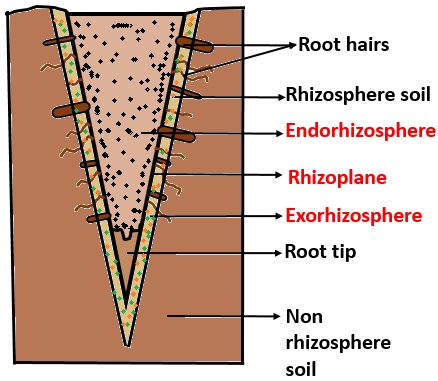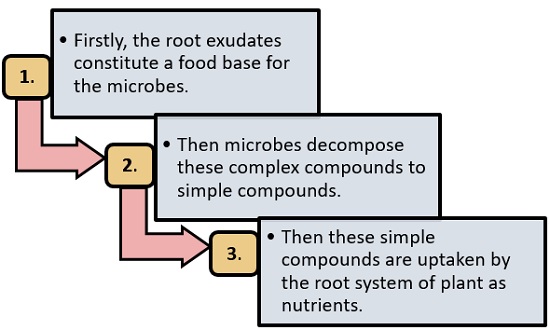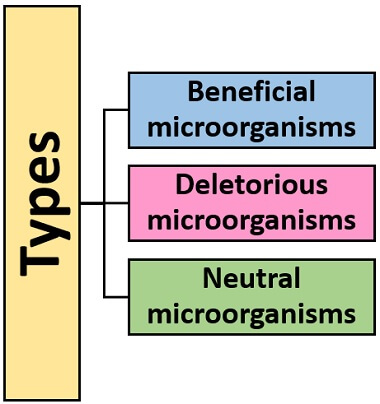The rhizosphere is a term, which was first introduced by a scientist L.Hiltner. It is the region that is a few distances (2-80mm) extended from the root system. It can also define as a zone, which favours the physical and chemical activity of the microorganisms and responsible for the intense microbial activity.
The rate of microbial activity strongly influences the process of root exudation. The organic and inorganic wastes of the root system are called root exudates. Rhizosphere zone is the region of intense microbial activity, and it is isolated from the bulk soil that often called as Edaphosphere or Non-rhizosphere.
A rhizosphere is a region containing a tremendous amount of rhizodeposits that makes it the most desirable zone for the microbial proliferation. We can remind the term, by understanding a simple fact that is a sphere containing root secretions and diffusates which is in close vicinity to the rhizoplane or root surface.
In this context, we will look into the location of the rhizosphere, rhizospheric effect, microorganisms involved and their activity along with the fundamental process related to the rhizosphere, i.e. root exudation.
Content: Rhizosphere
- Definition of Rhizosphere
- Structure
- Microbial Activity
- Root Exudation
- Classification of Root Exudates
- Role of Root Exudates
- Factors Affecting Root Exudation
- Rhizosphere Effect
- Rhizosphere Microorganisms
- Factors Affecting Rhizosphere Microorganisms
Definition of Rhizosphere
The term rhizosphere can define as the microzone of soil biota, which has a distance few millimetres away from the root system. It is the region where the plants and microbes coordinate with each other and can show the symbiotic relationship by fulfilling each other’s nutrient requirement. The size and structure of the rhizosphere zone vary depending upon different plant species and microflora present in it.
Structure
Structure of rhizosphere consists of three zones based on their proximity to the root system.
- Inner zone: It is also termed as Endorhizosphere. It is very close to the root. It includes the portion of cortex and epidermis, in which the microorganisms may occupy between the vacant space known as Apoplastic space.
- Rhizoplane: F.E. Clark coined this term. It is the root system itself.
- Outer zone: It is also known as Exorhizoshere. This layer is adjacent to the portion of the epidermis.

Microbial Activity in Rhizosphere Zone
The whole process inside the rhizosphere zone is explained below in the diagram:

Root Exudation
The reason for intensive microbial activity is due to the phenomena called Root exudation. During unfavourable conditions, the organic and inorganic compounds diffuse out of the root, such compounds are called Root exudates. Therefore, root exudates form a network between the plants and microorganisms. Root exudates basically include the root secretions and root diffusates.
Classification of Root Exudates
Based on chemical nature, root exudates are of three types:
- Organic compounds: These are the compounds that consist of carbon molecule as a backbone, which can be covalently linked to the other molecules like hydrogen, nitrogen etc.
Examples: Proteins, organic acids, vitamins, amino acids, sugars, flavonoids, nucleotides, enzymes etc. - Inorganic compounds: These are the compounds, which consist of carbon or hydrogen, but not together.
Examples: Water, anions and gases like carbon, oxygen, nitrogen etc. - Miscellaneous compounds: Other than organic and inorganic compounds, some other substances are also released by the plant, which can impose a negative effect and called as miscellaneous compounds.
Examples: Auxins, glycosides, saponins, hydrocyanic acids etc.
Role of Root Exudates
- It provides nutrient supply to the microbes.
- Root exudates protect the plant from desiccation.
- It provides moisture to the soil, which favours the growth of microorganisms.
- By releasing some defence proteins and antimicrobial chemicals, it also protects the root against biotic stress, i.e. pathogens.
- It induces systemic resistance against abiotic stress like temperature, salt concentration, pH.
- By mucilage secretion, it helps in soil aggregation.
- It can change the chemical and physical properties of the soil through the following factors:
- Osmotic pressure
- Ionic balance
- Redox potential
Factors Affecting Root Exudation
- High temperature and light
- Wilting of plant releases a high amount of amino acids
- A release of secondary metabolites by certain microorganisms
- Rhizospheric microflora that can affect the permeability and metabolism of root
Rhizosphere Effect
Rhizosphere effect is an important term that quantitatively measures the microbial count in the rhizosphere zone. It states that the number of microorganisms present in rhizospheric soil to that of Edaphosphere or non-rhizospheric soil. It is denoted as R:S ratio. The rhizosphere effect is different for different microbes that are present in the rhizosphere. Its value ranges from 5 to 20.
Rhizosphere Microorganisms
Rhizosphere shows huge microbial diversity, which includes (Bacteria, fungi, actinomycetes, algae and protozoa are the common microbes, whereas viruses, archaea, arthropods are very rare). Microorganisms can be classified into three types based on their effect:

Beneficial microorganisms: These do not harm the root system and includes mycorrhizal fungi, protozoa, N2 fixing bacteria etc.
Role of beneficial microorganisms:
- Fixes nitrogen
- Helps in solubilizing inorganic phosphate, iron etc.
- Helps in root nodulation
- Colonize the root system
- Promotes plant growth
Deleterious microorganisms: These harm the root system of soil and includes the pathogenic fungi, bacteria, nematodes etc.
Role of deleterious microorganisms:
- Cause diseases in plant
- Invades nutrient
Neutral microorganisms: These show a neutral effect and includes actinomycetes, algae etc.
Role of neutral microorganisms:
- Helps in soil aggregation
- Shows antagonistic property against other organisms
Table showing distinctive features of rhizosphere microorganisms is given below:
| Microorganisms Involved | R:S Effect | Examples | Functions | |
|---|---|---|---|---|
| Bacteria | •Smallest among all •Most abundant •Extensively found in root hairs rather than root tip •Aerobic bacteria are less in number •Gram negative bacteria are predominant | 10-20 or more |
|
|
| Fungi | •Abundant after bacteria •Both mycorrhizal and pathogenic fungi are associated | ≥ 10 | Mycorrhizal fungi Pathogenic fungi:
|
|
| Actinomycetes •Interlinked between bacteria and fungi •Gram positive, prokaryotic organism | •Interlinked between bacteria and fungi •Gram positive, prokaryotic organism | Approximately 2:1 or 3:1 |
|
|
| Algae | •These are aerobic and photoautotrophic moisture content and light favours its growth | 2:1 |
|
|
| Protozoa | •Includes: small flagellates, ciliates and amoeba •Flagellates and amoebae are dominant than ciliates •Found in water films of root hairs ejected out of epidermis wall | 2:1 |
|
|
Factors Affecting Rhizosphere Microorganisms
- Type of soil: A microbial population is very high in sandy soil and least in humus soil.
- The moisture content of soil: Low moisture favours the growth of organisms.
- Soil amendments: It has no quantitative and qualitative effect on microbial growth and activity.
- The pH of soil: It is inversely proportional to the microbial growth, i.e. a decrease in pH results in an increase of the microbial population.
- Plant species: Microorganisms vary with different plant species respective to their rooting habits, composition etc. For instance, leguminous plants show more rhizospheric effect.
- The proximity of root with hair: Rhizosphere effect is more when there is a less distance between the soil and root. As the R:S effect increases, the number of organisms will also increase.
- Age of plant: It is an essential factor, which decides the degree and magnitude of rhizosphere effect. R:S effect is directly proportional to the age of the plant, i.e. it increases with the age of the plant.
- Root excretion: This process strongly influences the microbial activity by providing a sufficient amount of organic and inorganic matter to the rhizospheric microorganisms.
These all are the factors that influence the growth and the activity of the rhizosphere microorganisms directly or indirectly.
Thanks for this explicit article,
Full information pertaining to cogent contents are discussed here. So helpful!